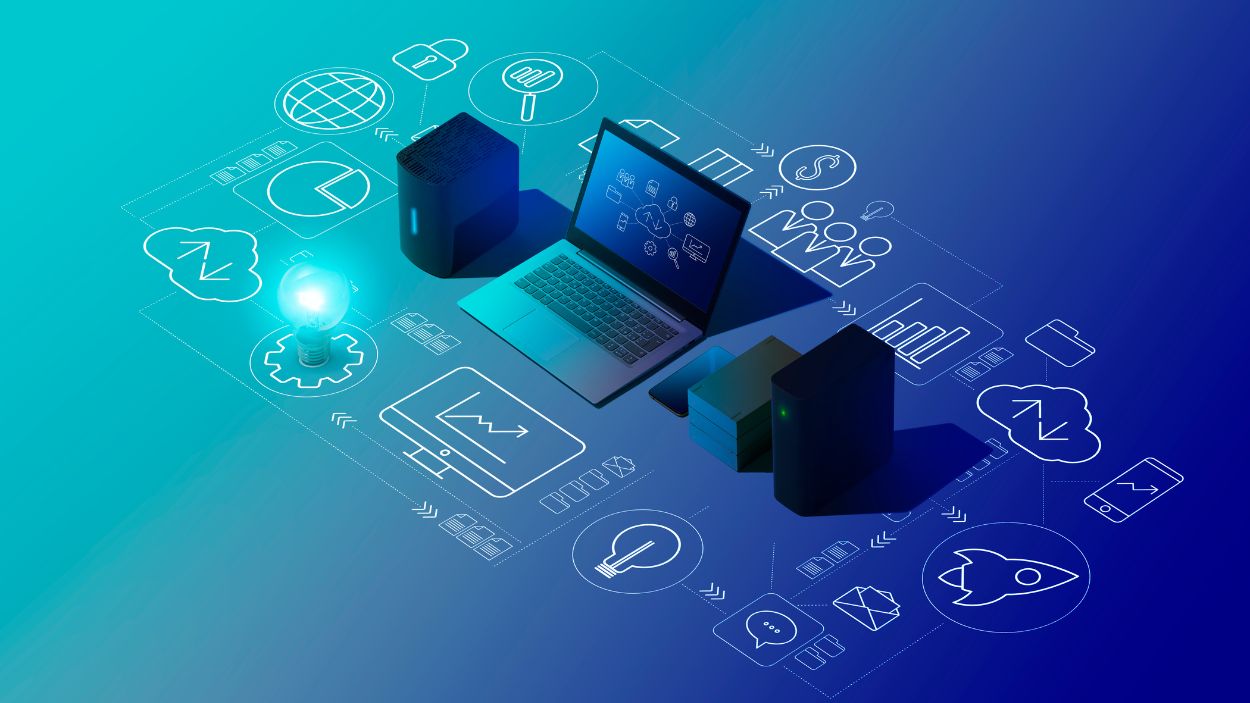Contents:
Keeping track of laptops, phones, and IoT devices can feel like herding cats, especially with remote work on the rise.
That’s where endpoint management software steps in making it easier to protect data, stay compliant, and manage your tech.
In this article, I’ll dive into what endpoint management is and share 9 standout tools to keep devices safe and your business running smoothly.
Key takeaways:
- Heimdal – A modular, AI-powered endpoint management platform that unifies security tools like patch management, remote desktop, and DNS protection into a single, customizable dashboard.
- Cynet – A 24/7 automated security solution that detects and responds to threats in real-time, using deception technology and honeypots to trap hackers.
- Action1 – A cloud-based endpoint management system designed for remote and hybrid teams, offering automated patching and real-time monitoring from anywhere.
- NinjaOne – A user-friendly IT management platform with strong automation, remote troubleshooting, and flexible reporting features to enhance endpoint security.
- Microsoft Intune – A cloud-based Unified Endpoint Management (UEM) tool that seamlessly integrates with Microsoft Defender and other Microsoft services for centralized security and compliance.
- VMware Workspace ONE – An enterprise-grade multi-platform endpoint management solution that provides secure access to applications and integrates with VMware’s ecosystem.
- Sophos Mobile – A UEM platform that integrates with Sophos Intercept X, offering advanced malware detection, real-time threat protection, and strong security for mobile devices.
- Kandji – A specialized Apple device management platform that automates security, compliance, and app updates while leveraging Apple-specific security features.
- IBM Security MaaS360 – An AI-driven endpoint management solution that enhances security and compliance with intelligent automation and cloud-based management.
Endpoint management software benefits
Endpoint management software is not just one more nice-to-have app. Getting all assets under the same umbrella makes it easier to ensure maintenance and security.
The rapid turn towards a hybrid work environment and businesses running offices worldwide made endpoint management software a central pillar for productivity and safety. Here are some top endpoint management software benefits.
Full visibility over the company’s devices
Imagine a 1000-employee company with laptops, phones, IoT devices, and a remote work policy. If no one knows for sure where and how many these devices are, or what software is running on them, it’s mission impossible to keep them safe.
IT teams need a clear view of all the company’s devices and processes on one screen. They need to see which devices miss updates or aren’t following company rules. Full visibility is the first step towards security and is one of the benefits of using endpoint management software.
Stronger endpoint security
Hackers often target laptops or phones to get initial access into a company’s network. Endpoint management software can act like a guardian for these devices. Its weapons are tools like antiviruses, advanced threat detection, access management and more. For instance, traditional antiviruses scan the files on an endpoint and compare them against a database of known threats. If they find a match, they isolate and block the file immediately. Thus, the antivirus prevents further damage.
Best endpoint management software goes even further. It uses AI trained behavior analysis to detect unknown threats and suspicious activities.
Increases operational efficiency
Updating every device in a company can take hours or even days if done manually. Advanced endpoint management software can automate this process. Automation enables you to install updates or patches on hundreds of devices with a few clicks. This saves time, energy, and reduces the risk of human error.
Supports hybrid work environments
In a hybrid workplace, employees use their devices from home, cafes, or the office. Keeping these devices safe and running smoothly can be tricky.
Endpoint management software makes this easier by applying the same security rules to all devices, no matter where they are. For example, a remote worker’s laptop gets updates and security checks, just like someone in the office.
Supports compliance with industry standards
Companies often need to follow rules to protect customer data, like GDPR, HIPAA, NIS2, or DORA. If they don’t, they could face big fines.
Endpoint management software helps ensure a continuous compliance process. For example, it reminds and supports the IT team to install patches or make sure sensitive data in transit or in storage is encrypted.
Top 9 endpoint management software
This is my personal top 9 endpoint management software list. Most of those solutions offer must-have features like centralized control or automation. The difference is, as usual, in the details: how easy to learn and use they actually are, how extensive the automation capabilities are, and what did former users have to say about them.
Once you’re through with this list, I encourage you to make your own top 3 or 4 before making a decision. For those few finalists take the time to book a free demo and/or a free trial, if available. Seeing the software at work is the best way to know their true value.
Heimdal
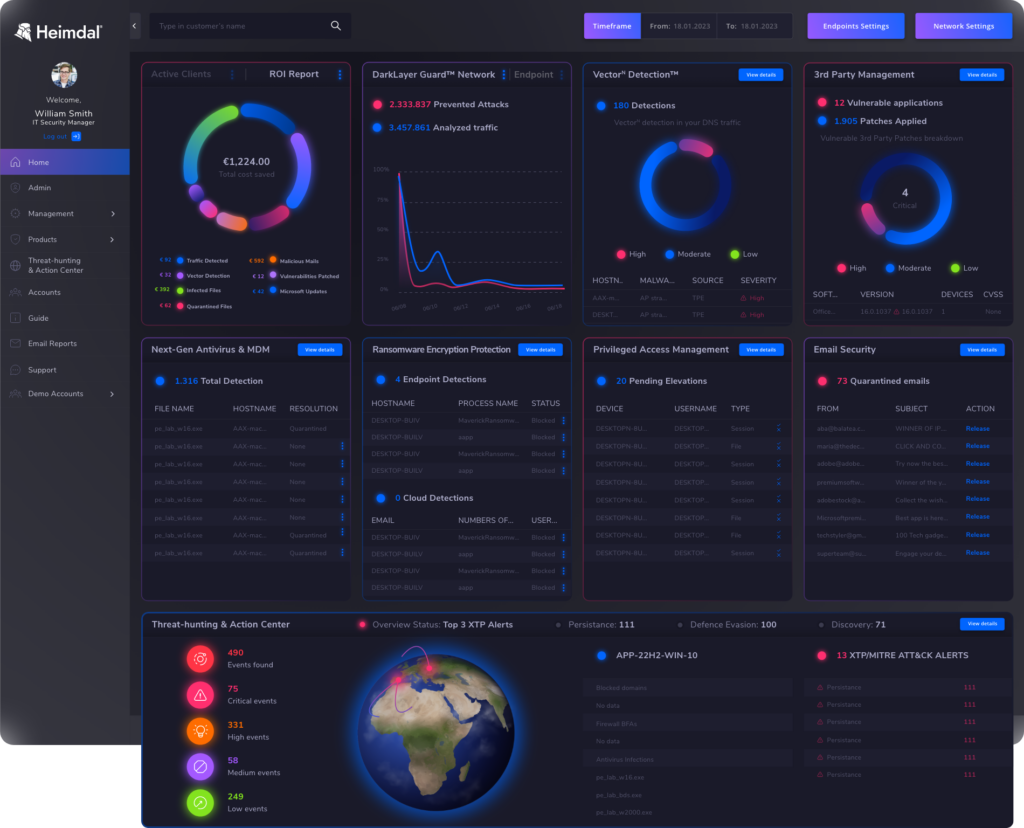
Heimdal XDR is a powerful, unified endpoint management platform that helps manage and protect your company’s devices from one place. It brings patch and asset management, remote desktop, application control, DNS security, and more to the same page. It’s a modular type of platform, so you can mix and match exactly the tools you need. Thus you’re only paying for what you really use, saving time, team effort, and money.
Key features:
- Unification
Heimdal brings together 10 different tools, from patch management to remote desktop and app control. Instead of managing each tool separately, you can control everything from a single dashboard.
- AI-powered behaviour analysis
The system uses AI-powered behavioral analysis to predict and stop threats before they can cause harm.
- Automation
Heimdal automatically updates software across all devices. Its patch and asset management tool solves asset inventory, installing, updating and uninstalling apps in a few clicks.
- Integration
Heimdal integrates well with other tools. If you already use Remote Monitoring and Management (RMM) from another vendor, you can easily integrate it the new tool mix.
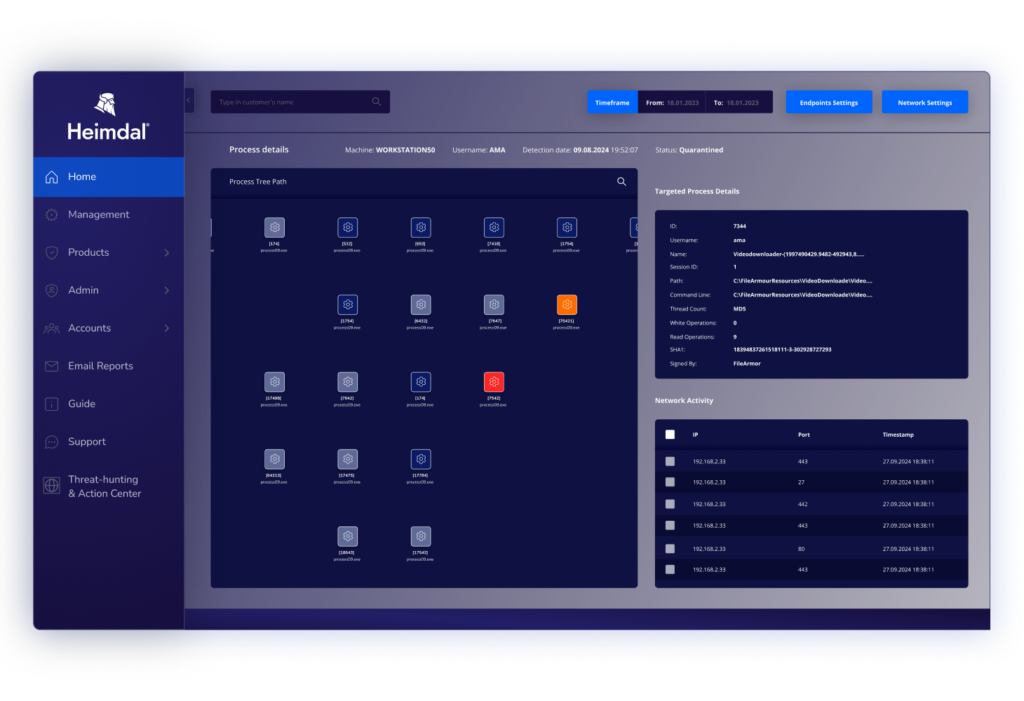
Pros:
- Full visibility due to its unique dashboard
- Modularity supports the freedom to mix whatever tools you need
- Strong AI-powered protection stops threats before they start.
Cons:
- Some features may require a bit of training to use effectively.
Pricing:
Heimdal offers customized Pricing that fits various business requirements and usage patterns. To see Heimdal in action before making any commitments, book a demo.
Cynet
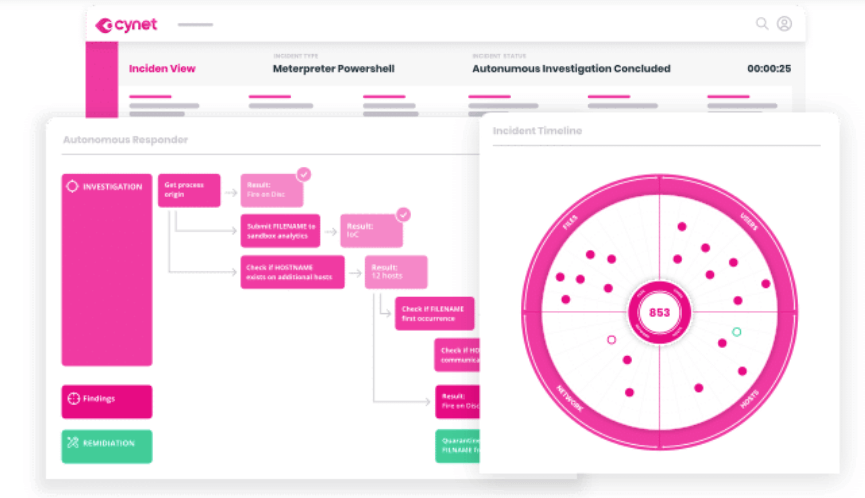
Cynet is like having a 24/7 security guard for your company’s devices. It monitors devices for threats continuously and uses automated incident response when needed.
Key Features:
- Real-time threat detection
Cynet uses real-time threat detection to spot suspicious behavior. It doesn’t wait for you to notice there’s an issue; it acts on the spot to protect your devices.
- Can set honeypots
By using deception technology and fake vulnerabilities it tricks hackers into revealing their plans.
- User-friendly platform
Cynet’s platform is simple to use and works well for small and medium businesses. If you’re not running large and complex infrastructures, with different OSs, it’s a good match.
Pros:
- Provides automatic response to detected threats.
- Fast to signal out potential USB infection cases, according to user reviews
- Great for smaller teams that need strong protection.
Cons:
Some user reviews on Gartner say removing endpoints can be difficult in some cases
It’s very hard to remove end points from the main portal and in some cases its not possible to remove devices fully with some assets showing on there from some time ago.
Pricing:
Cynet’s pricing starts at USD 7 per month per endpoint.
Action1
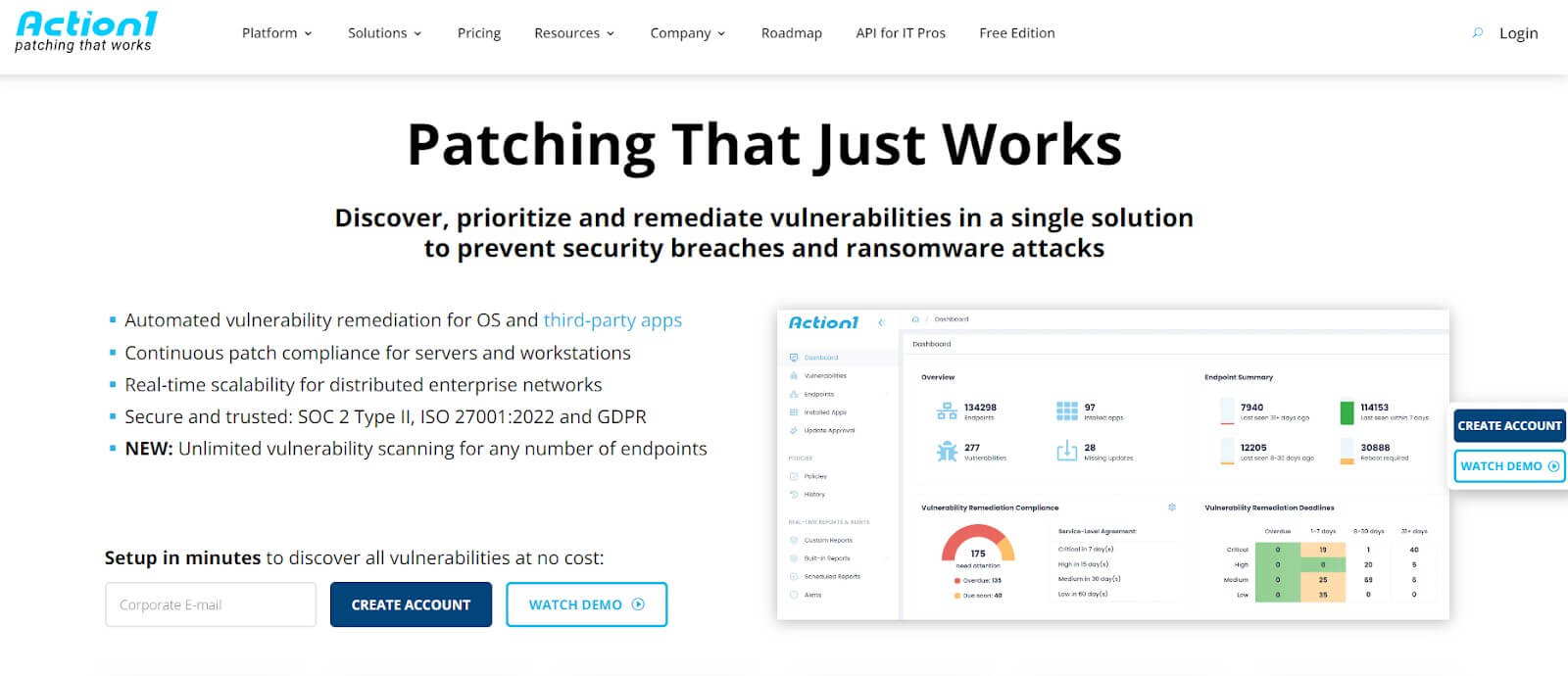
Action1 is a cloud-based endpoint management solution particularly useful for hybrid or remote work environment organizations. The solution keeps devices up to date, secure, and working properly, no matter where the user is.
Key features:
- Automation
Action1 automates patching and app deployment, making maintenance tasks easier for IT teams.
- Real-time monitoring
Real-time monitoring helps find and address potential infection before it spreads further.
- Cloud-Based Management
The system works entirely in the cloud. Thus, you can manage devices from anywhere, whether your team is in the office or remote.
Pros:
- Excellent for remote work environments.
- Free plan for small teams.
- Easy to set up and start using.
Cons:
- May not have as many advanced features for large organizations.
Pricing: Action1 offers customized pricing.
NinjaOne
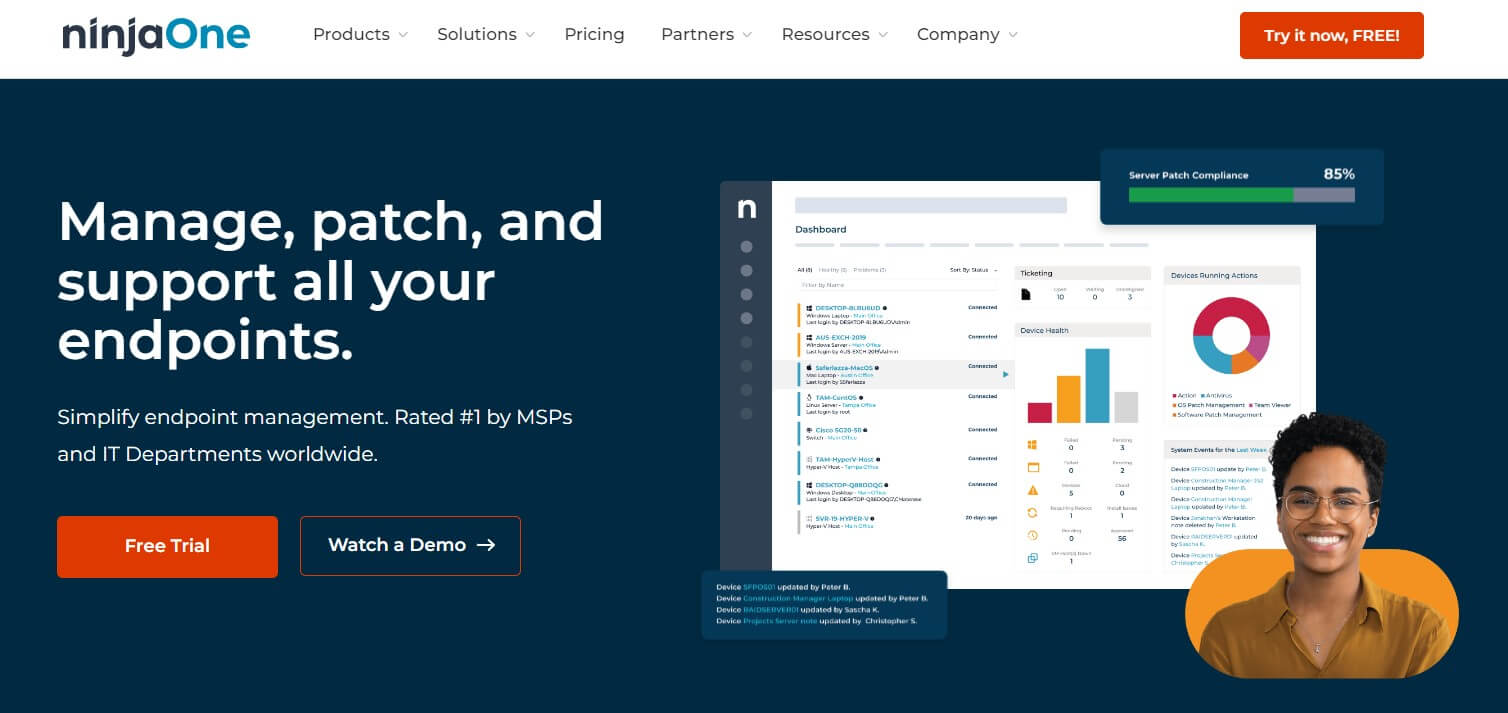
NinjaOne is known for its easy-to-use interface and strong automation features. It simplifies endpoint management and other IT tasks.
Key features:
- Automation
NinjaOne’s easy-to-use platform automates tasks like patching, performance monitoring, and reporting
- Remote desktop capabilities
System Administrators can safely connect and troubleshoot to remote devices.
- Flexible reporting
The solution enables you to create and manage custom fields and extract reports on any data you need. This feature supports compliance processes as well as internal productivity-related reporting.
Pros:
- Easy to deploy and set up.
- Remote troubleshooting to quickly solve device issues.
- Strong reporting and analytics to track device health and security.
Cons:
Some users signaled that you can only schedule maintenance mode manually. Otherwise you’ll get lots of unnecessary alerts about servers being down.
No ability to schedule maintenance mode currently so you will have to do this manually or you will be spammed with alerts that your servers are down. MDM management is there but limited, they are adding more to this I believe.
Source – User review on Gartner
Pricing:
Pricing is available upon request.
Microsoft Intune
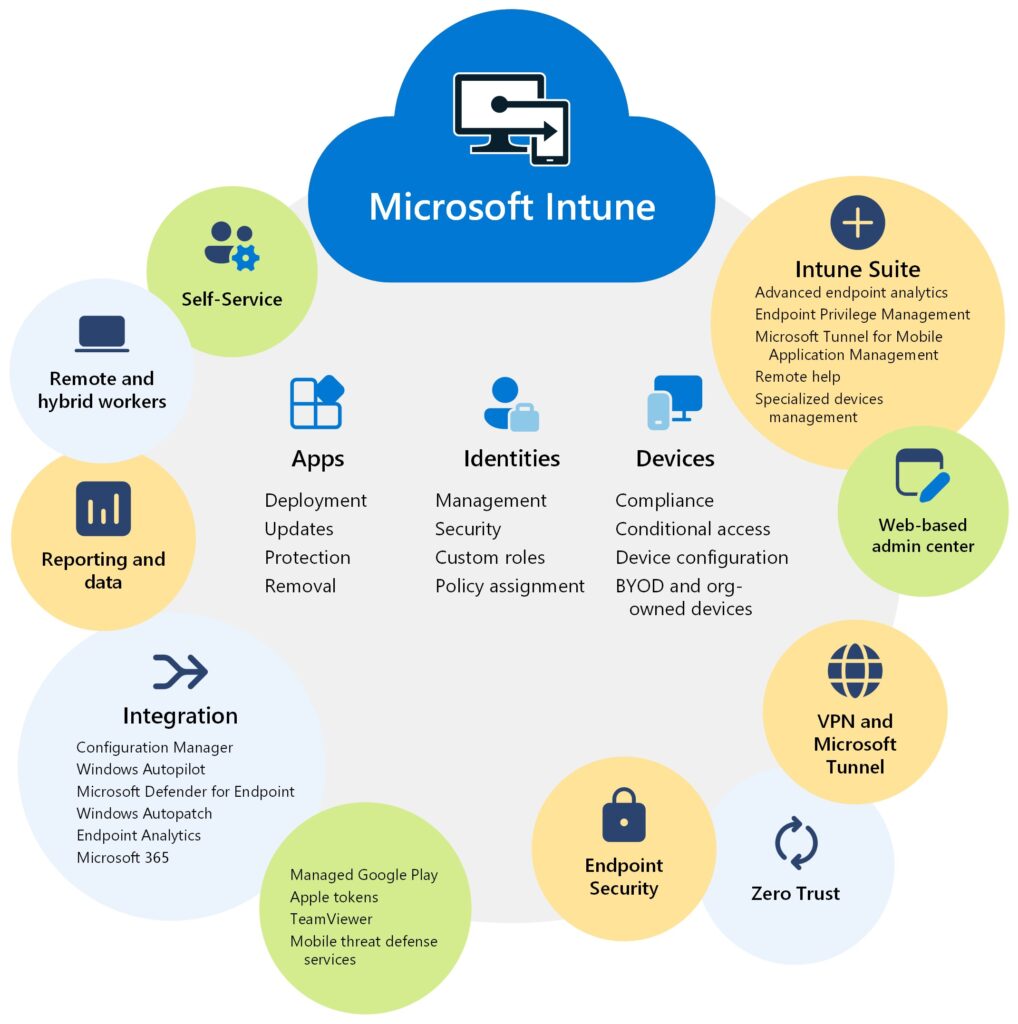
Microsoft Intune is part of Microsoft’s suite of tools. This cloud-based UEM platform helps manage and secure company devices and apps. It’s great for businesses already using Microsoft products because it integrates well with other tools.
Key features:
- Unified console
Intune helps manage both mobile and desktop devices and software from a single console.
- Seamless integration with Microsoft Defender and third-party services
Intune integrates with Microsoft Defender for Endpoint and third-party partner services to enhance endpoint security. With these integrations, you can create policies that respond to threats, perform real-time risk analysis, and automate remediation.
- Admin center for endpoint management
The Intune admin center focuses on endpoint management with data-driven reporting. Administrators can sign into the admin center from any internet-enabled device, making it highly accessible.
Pros:
- Excellent integration with Microsoft products.
- Strong device and app management capabilities.
- Cloud-based for easy access and management.
Cons:
This platform is, according to some users, hard to learn and lacks customization capabilities.
Pricing:
Subscription plans start at USD 8 per user per month for the basic bundle.
VMware Workspace ONE
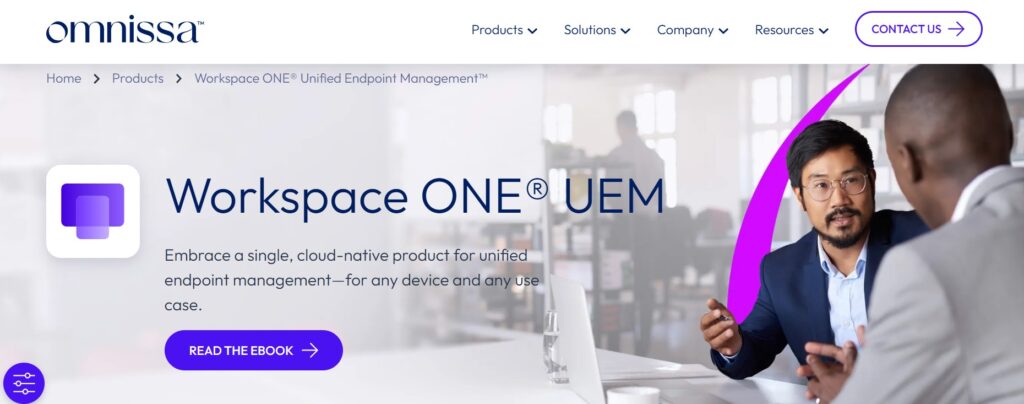
VMware Workspace ONE is an enterprise-level platform that manages and secures all endpoints. It’s great for larger businesses with complex IT needs.
Key Features:
- Multi-platform support
Workspace ONE offers multi-platform support, allowing businesses to manage all their devices from a single dashboard, regardless what operating system they use.
- Secure app and resource access
It allows access to apps and resources securely from the cloud or on-premises.
- Integration with VMware tools
Workspace ONE seamlessly integrates with other VMware tools, enhancing its functionality and compatibility within the VMware ecosystem.
Pros:
- Strong security features for enterprise-level protection.
- Supports all types of devices from one platform.
- Allow users to sign in once to access multiple resources.
Cons:
Can be too complex for smaller businesses or teams without dedicated IT staff.
Pricing:
Pricing starts at USD 5.40 per user per month for the basic plan.
Sophos Mobile
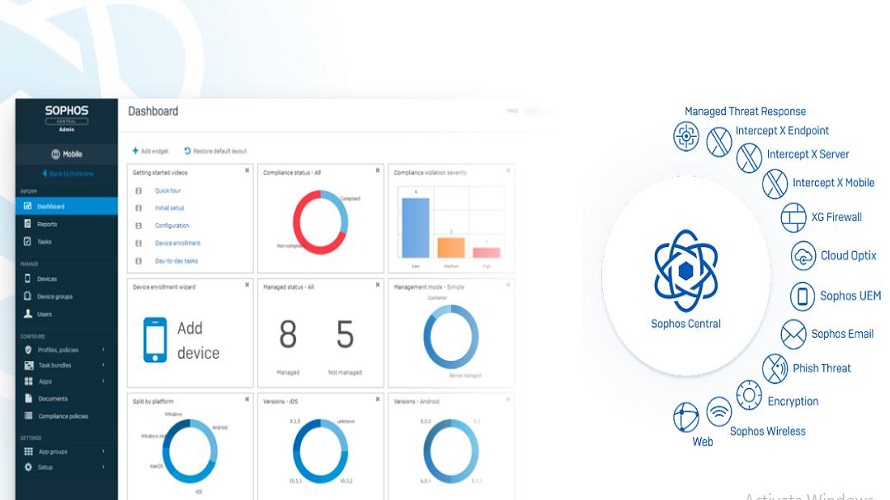
Sophos Mobile is a UEM solution with native integration into Sophos Intercept X. It provides advanced malware detection and anti-phishing.
It integrates XDR, allowing mobile threat data to enhance security operations and threat analysis.
Sophos Mobile works for both corporate-owned and BYOD environments. The solution offers features like Android Enterprise Work Profile and iOS User Enrollment. Thus it secures business data while also respecting user privacy.
Key features:
- Real-time threat detection
Sophos Mobile offers real-time threat detection and protection against malware, ransomware, and other threats.
- Up for a quick start
The solution doesn’t need server installation, so you can start using it in only a few minutes.
- Integration with Sophos Endpoint Protection
Sophos integrates well with Sophos endpoint protection, providing extra layers of security.
Pros:
- Great for managing mobile devices due to its integration with Intercept X for advanced malware protection and flexible options for corporate-owned and BYOD setups. Features like Android Enterprise Work Profile ensure robust security while respecting user privacy.
- Strong data protection and security.
- Allows users to securely distribute company documents to mobile devices
Cons:
Reviewers mentioned that:
Support for Windows enabled devices is not good as compared to MacOS and Android enabled devices.
Pricing: available on request.
Kandji
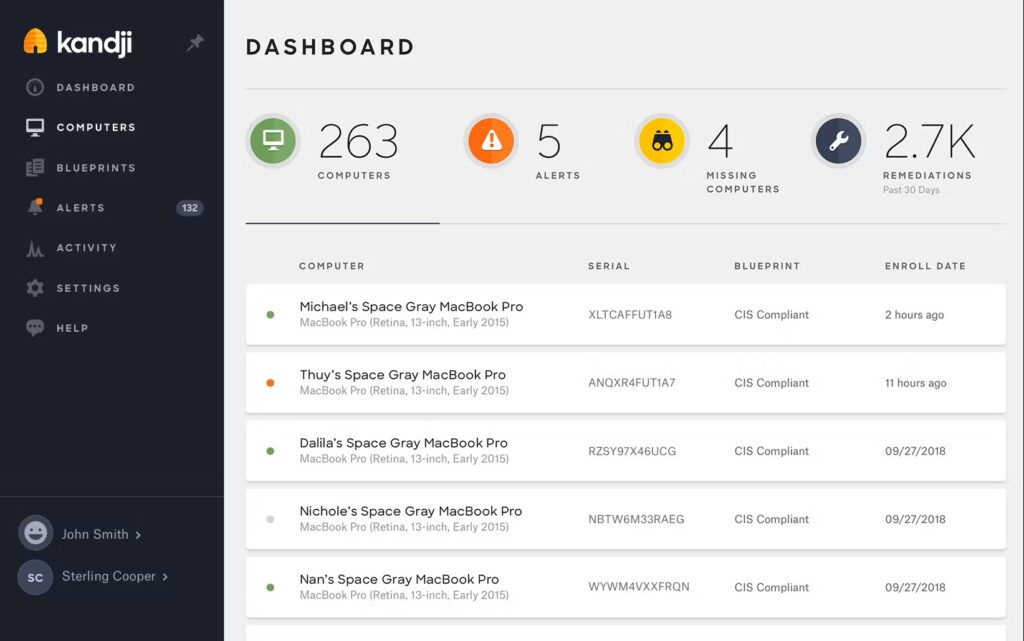
Kandji is a powerful solution specifically designed for businesses that use Apple devices like MacBooks, iPhones, and iPads. It automates the management and security of these devices, making it easy for IT teams to keep everything running smoothly without a lot of manual effort.
Key features:
-
Automated Device Management: Kandji automates device enrollment, app management, and security updates specifically for Apple devices.
-
Apple-Specific Security Features: Kandji leverages Apple-specific security features, including device encryption and compliance tools such as a password manager, FileVault enforcement, and app whitelisting
-
Easy to generate compliance reports
Pros:
- Perfect for Apple-centric businesses.
- Automates device management tasks.
- Ensures compliance with Apple’s security standards.
Cons:
Only works for Apple devices.
Pricing
Pricing starts at USD 1.60 per user per month for the basic plan.
IBM Security MaaS360
 IBM Security MaaS360 differentiates by its AI-driven approach. This endpoint management software helps IT teams proactively address security and management challenges. The software simplifies workflows, boosts user productivity, and ensures compliance—all while keeping things efficient.
IBM Security MaaS360 differentiates by its AI-driven approach. This endpoint management software helps IT teams proactively address security and management challenges. The software simplifies workflows, boosts user productivity, and ensures compliance—all while keeping things efficient.
This solution simplifies complex workflows, boosting user productivity, and ensures compliance. Modern businesses benefit from its intelligent automation. Intelligent automation not only streamlines redundant processes but also uses AI to make smart decisions on the spot.
Unlike standard automation, which blindly follows set rules, intelligent automation adapts and learns, making it a better fit for today’s fast-changing work environments.
Key features:
- Comprehensive endpoint management
Provides comprehensive endpoint management for a wide range of devices.
- Data encryption and threat protection
Includes data encryption, app management, and threat detection to keep devices safe.
- Cloud-based management
Offers cloud-based management for easy access and control.
Pros:
- Comprehensive security features.
- Works with a variety of devices.
- Cloud-based for easy management.
Cons:
Several user reviews say IBM Security MaaS360 is hard to learn. Its knowledge center might be confusing for beginners. Some reviewers said they needed better guidance to fully understand the product.
Pricing
Pricing starts at USD 4 per client device per month for the basic plan.
How to choose endpoint management software
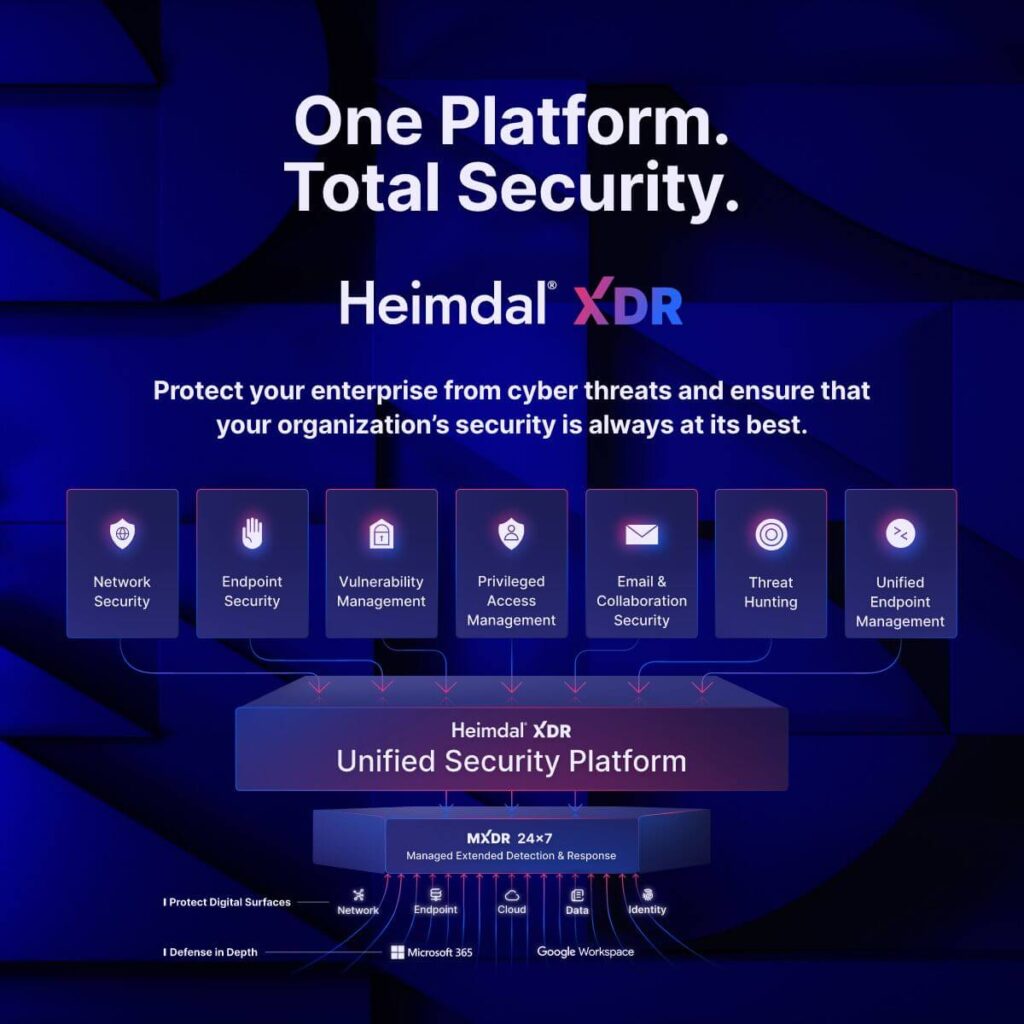 Selecting the right endpoint management software can feel overwhelming. So, let’s break it down into a few key steps.
Selecting the right endpoint management software can feel overwhelming. So, let’s break it down into a few key steps.
Assess existing infrastructure
Before picking an endpoint management software, figure out what your business truly needs.
Start by understanding your company’s current setup. How many endpoints do you have? What types of devices are they?
Are they running different operating systems like Windows, macOS, Linux, or Android? Also, consider your work environment—do you have an office-based, hybrid, or fully remote setup? For example, if your company has a hybrid work environment and uses both Windows and macOS, you’ll need an endpoint management solution that supports multiple OSs and works seamlessly for remote teams.
Human resources
Check whether your IT team is equipped to handle the new software.
- Team size and expertise: If your IT team is small or not experienced with managing endpoint security, look for user-friendly solutions with automation features like patch management or remote monitoring.
- Consider outsourcing: If you don’t have in-house experts, consider working with a Managed Service Provider (MSP) or a Managed Security Service Provider (MSSP). These professionals can handle endpoint management for you. Tip: Involve the people who will use the software (like your IT team) in the decision-making process. Their input will ensure you pick a tool that fits their workflow.
Industry-specific compliance requirements
Many industries have strict rules about protecting data and devices.
- If you’re in finance, healthcare, or any field that deals with sensitive information, you’ll need software that meets compliance requirements, like NIS2
- Look for solutions that offer audit trails, data encryption, and compliance reporting to help you pass compliance audits.
Compare demos and free trials
Top endpoint management solutions usually provide demos or free trials so you can test their features.
- What to look for: Use this opportunity to check how easy the software is to navigate. Is the dashboard user-friendly? Does it automate tasks like patch management or app control? Can it handle the variety of devices your company uses?
- Test real-world scenarios: For example, test how long it takes to deploy patches to a large group of devices or whether the software integrates smoothly with your existing tools.
Check customer support
Good customer support is crucial, especially if you’re using a new tool for the first time.
- Look for vendors offering 24/7 support, detailed documentation, and training resources.
- Read reviews from real users to get a sense of their experience with customer support.
Here’s what users are saying about some of the top endpoint management software:
Heimdal
Heimdal’s unified platform makes managing multiple endpoints so easy. The customer support is incredibly helpful and quick to respond. Integration with our existing tools was seamless!
Action1 RMM
I love that Action1 lets me deploy patches remotely. The interface is simple, but sometimes there’s a delay with updates.
Kandji
Kandji is a dream for managing Apple devices. The automation features save so much time! However, it’s expensive for smaller teams.
VMware Workspace ONE
It’s great for handling a large number of devices and has tons of features. But setting it up can be complicated, especially for new users.
Take control of your endpoints today
Keeping company devices safe and running smoothly can make the difference between failure and success for a business. That’s why choosing an endpoint management software is an important decision. When done well, endpoint management:
- protects your data
- fixes occasional problems quickly
- streamlines the workflow, whether your team is in the office or working from home
Among other top endpoint management solutions, Heimdal’s XDR platform stands out as one the best. It offers the most extensive toolkit in a modular way. . You can use it to automate updates, control what apps are allowed to run, stop attacks with Ransomware Encryption Protection, and manage all your devices from one easy-to-use dashboard.
Also, if you want to keep some of your in-place tools, this highly integrative platform makes it possible.
Ready to see how Heimdal can help? Book a demo today and take control of your devices!
FAQs
What is endpoint management software?
Endpoint management software is a tool that helps businesses keep track of, perform maintenance tasks, and protect all their devices2. Why do companies need endpoint management software?
Companies need endpoint management software to gain visibility over their assets, protect data, fix problems quickly, and save time. It helps keep hackers out, ensures all devices are up to date, and makes managing devices much easier for IT teams.
What features should I look for in endpoint management software?
Look for tools that make managing devices simple. The best ones offer automated updates, strong security, easy-to-use dashboards, and work with different operating systems. Also, choose software that fits your company’s size and needs.
If you liked this article, follow us on LinkedIn, Twitter, Facebook, and Youtube, for more cybersecurity news and topics.










 Network Security
Network Security
 Vulnerability Management
Vulnerability Management
 Privileged Access Management
Privileged Access Management  Endpoint Security
Endpoint Security
 Threat Hunting
Threat Hunting
 Unified Endpoint Management
Unified Endpoint Management
 Email & Collaboration Security
Email & Collaboration Security


